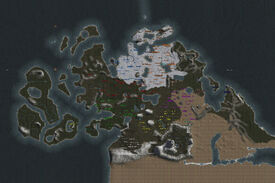
The continent of Perisno
Perisno is one of the great continents of the world. Perisno is surrounded by the Brumal Sea to the north, the Peligan Ocean to the east, and the Shining Ocean to the west. The continent includes the Vernal Islands and the Isle of Steel, among several other islands scatterd around the northwestern shore of the land. Perisno is home to 15 major land-holding factions by the year 365, as well as over 20 minor factions and outlaw groups vying for power.
History
Early civilizations (1,000 BE - 680 BE)
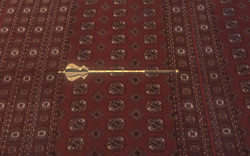
Bronze mace of giant origin, c. 7,500 BE
Perisno is thought to be the first inhabited territory in the world, with the first of these inhabitants being the ancient races of the land: the giants , the elves, dwarves and humans. The humans, known as Perilo, had numbers much smaller than the other races. The elves and dwarves lived in relative isolation, with the former confined to the deep western forests and the latter relegated to the tall southern mountains. There was little conflict between these different groups owing to their geographical isolation as well as the relatively sparse population density of the continent as a whole. Giant and Dwarven history was not recorded in the Great scrolls, so hardly anything was known about them till much later.
This balance of power began to shift with the Perilo growing in large numbers and taking over great amounts of land. in the centuries after 1000 BE. The increased competition for land drove both humans and elves to assert themselves more on the continent, driving large populations of giants eastward as early conflicts began to erupt. Though major powers were yet to emerge, the original Perilo (who named themselves the Kingdom of Perisno much later) had settled in the central part of the lands (700 BE), while the Venetoran people and the Klymorian Tribes started expanding their borders. The venetoran people split from the Perilo very early on and thus claimed their own lands as their disputes grew. Not much is known where the Klymorians came from. They seem to be more mysterious than all the other inhabitants.
680 BE- 450 BE
The original Kingdom of Perisno came to be known around the year 680 BE. They had flourished under King Garrcick and their extended peace lasted for over four centuries. Smaller surrounding tribes were soon consumed by the growth and Garrcick claimed even more land through diplomacy. His armies never really had to fight the much smaller fragmented tribes as they saw there was no need to oppose Garrcick’s rule. The central plains and forests soon belonged to his growing Kingdom.
In the year 450 BE, a scouting party ran across a village belonging to the Klymorian tribes, (eventually known as the Klymorian Empire). The king at this time, Haggenhold, third of his name, was leading a kingdom that was seeing it’s most prosperous times yet. He was a fair king to an extent, though he had a nasty temper where he would be holed up in his castle for days without emerging. With the discovery of a new kingdom, Haggenhold sent out emissaries to see and learn more about these Klymorians. Without warning they were slain and returned to the king with their heads cut off. This gruesome act would lead to the eventual spark of the greatest war the land had ever seen.
450 BE- 0 BE
In the year 447 BE, Prince Kangrive of Perisno was leading a scouting party on the orders of King Haggenhold to scout out the vast woodlands to the west. He grew more and more suspicious of the surrounding lands and what lay beyond his maps. This led to his discovery of the Elves (eventually known as Elintor).
note, more in depth lore will be made public soon. This is just the main Intro/Overview.
Venetoran supremacy (100 BE—68 BE)
The Venetoran Empire was the dominant power in Perisno, and established the primacy of humankind on the continent. The institutions and culture of Venetor would have lasting impacts on Perisno successive kingdoms, and for the first time the people of Perisno began to attract notice of the peoples of other lands. Persecution of the giants increased under several Venetoran emperors, and the Grazir Worshippers began to practice their religion in contrast to the paganism that was common at the time.

Great Temple of Venetor
In the year 68 BE, however, there was a leadership crisis when Emperor Trilond died without a suitable replacement, and an ensuing civil war led to the total collapse of the great Empire and its dominion. The Venetoran Empire would survive only through the renegade Third Legion, a group of civilians and soldiers that would go into hiding from this day onwards.
Dark century (68 BE—1 BE)
The power vacuum left in the wake of this collapse led to a resurgence in popularity of the Demon Worshippers, who had for a long time been repressed by Venetoran authorities. In the final decade BE, a great darkness descended upon the land as the Demon Worshippers angled to eliminate opposition to their practices once and for all. Though still active societies, the elves, giants, and dwarves were not in a position to prevent this due to their isolation and disunity. The Third Legion, therefore, represented the biggest threat to the Worshippers way of life, and in the year 1 BE they began to amass their forces for an assault.

Third Legion holds the Grazir Worshipper Charge, 1 BE
With the help and leadership of a man that became known as the Lord of Faith, the Third Legion and its hastily organized allies defeated the much larger demonic army in the Battle for Enlightenment. This event marked a watershed moment in the religious and cultural history of Perisno, as the Lord of Faith became worshiped as a common deity and the Church of Faith was founded to facilitate these practices.
Very few know the real danger in the land was the Klyrintin Empire.
Elven golden age (0 AE—150 AE)
In the years after the Enlightenment, human influence in Perisno had been significantly reduced by the incessant conflict of the previous century. The elves that inhabited the western forests of the lands unified their people under one name: Elintor.
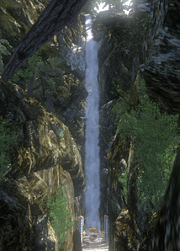
Elven Fountain Temple
With a renewed sense of purpose and a lack of major opponents, the Elintoran elves experienced a Golden Age of prosperity and peace that would last for almost two centuries. During this time, the elves constructed great cities in the dense forests of Perisno, celebrated the ancient tradition of Fountain Goddess alongside the modern practicing of the Church of Faith, and honed their special art of archery for the defense of their new kingdom.
As Elintor expanded and developed as a nation, it began to explore more of the continent as came into contact with many new human factions that had developed since the Enlightenment. Close to home, they encountered the Ankars , a group of female elves that had resisted unification and splintered off from mainstream elven society. The Elintorans ventured as far as to the snowy lands of the northeast, where they came in contact with the Illica Falki Raiders. They fought several battles against the Raiders and their Sky King, but were unable to defeat them and decided to retreat to the west.
Calm before the storm (150 AE—316 AE)
As the elves situated themselves as a major kingdom in the land of Perisno, there was another period of peace like the one that had existed previously under the Venetoran Empire. Elintor felt content with their position and prosperity, and chose to revert to isolationist ideals in place of warring with the minor factions that surrounded their domain.
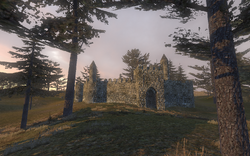
Azure Keep, constructed by Geldar in 227
At some point in the early third century, Elintor experienced their largest internal struggle to date when a minority group of Geldarin elves decided to split from the kingdom and rule independently on the western coast of the elven lands. The tension and fiercely hateful rhetoric that spawned from this event almost erupted into a full civil war, but the Geldar backed down when they realized they could not yet match the strength of the much larger and more established Elintoran kingdom.
A similar schism occured in the Church of Faith, when a council Paladin and his loyal followers abandoned the church and founded the Order of the Eagle , a militaristic organization dedicated to defeat the Demon Worshippers at all costs. This event would herald the increasing importance of military strength in Perisno, which would only become more apparent by the imminent arrival of foreign powers.
First arrivals (316 AE—330 AE)
In the year 316, there was a consolidation of power in the snowy northern lands of Perisno. The northern coast had long been home to groups of men living nomadic and seafaring existences, sustaining off of piracy and trade with the southern kingdoms and giants. The most powerful pirate leader, from the notorious Myrm clan, called for a ten-day truce on the seas, and held a meeting with other leaders to establish a more permanent solution to improve their situation in the land. The resolution that was established on that day held that the Myrm clan would rule over a senate of nobles from the other major clans, as part of the new cosmopolitan realm of Maccavia. This gamble proved to be a success- the economic knowledge of the nobility and the Maccavian people's experience with trade led them to great prosperity over the next five years.

Tower of Tolranus, constructed in 324 by King Calarin
It would not be long before Maccavia would find itself with a new neighbor. In the year 323, a small fleet of ships from the Old Hakkon Empire under the command of Captain Otto Waveshore reached the western shore of Perisno. The people they contained had fled from their tyrannical ruler and sought to establish a new kingdom free from the shackles of their former empire. They called themselves the Tolranians, and like Maccavia they found great initial success in the relatively uninhabited land they chose to begin their new lives due to trade with their neighbors to the north.
The very same year, there was another crisis facing the leadership of Elintor. Several Elintoran nobles, having witnessed the encroachment of these new foreign powers on Elintoran lands, were fearful of the conflict that they were sure would soon follow. Having adopted the ways of the Maccavian New Gods, they greatly valued peace and were committed to not become plunderers or aggressors. These nobles and their significant number of followers escaped to the isolated and distant mountains to the south of Elintor where their refugee civilization would develop into the Realm of the Falcon over the coming years. Though hostile towards this group of dissenters, Elintor failed to pursue the Falcon people due to their own preoccupation with defending their lands against the prospect of Tolranian incursions.
Hakkon armada and conflicts (330 AE—363 AE)
Much to the surprise and horror of the Tolranians, in the year 330 a great armada from the Old Hakkon Empire was spotted crossing the Shining Ocean towards Perisno. The fleet of Hakkon nobles and soldiers were fleeing the crumbling remains of their Old Hakkon Empire in the footsteps of the Tolranians, and quickly conquered a large swath of territory to the south of Elintor and the Kingdom of Tolrania thanks to their massive army.
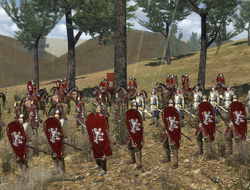
Westerly League forces at the Battle of Halfith
After seeing the ease with which the new Hakkon Empire was able to steamroll the few enemies they encountered, King Calarin of Tolrania decided to propse a defensive alliance with the Elintoran elves against the threat from the south. The elves agreed, thus creating the Westrey League in direct opposition to these new Hakkon invaders. In 332 AE, one year after the signing of this pact, King Hakkon IV decided to make his move northward. In a decisive battle, the Westrey League defeated the Hakkon army and prevented the further spread of the Empire for the time being.
The 30 years following this battle were marked with minor skirmishes between the new major powers of Perisno, however no true wars would erupt during this time. The Kuu-lan Horde would land in Perisno shortly after the Hakkon armada, having initially been called to support the invasion by Hakkon Emperor Comrey II. Upon the death of Comrey II in 330, the five sons of Kuu-lan decided to abandon the Hakkon cause and rule under their own banner on the eastern shore of the land.
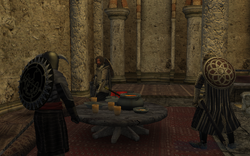
Yusuf al-Salah meeting with Draharan leaders Emir Grasullah and Vizier Khalil
354 marked another consolidation of power, similar to the one that had been seen in Maccavia 40 years prior. Yusuf al-Salah, a common man with great ambitions proclaimed himself a servant of the Draharan gods. He served the desert tribesman grand visions of a Perisno ruled by the united Draharan people, a messge that resonated with the people who had seen their position in the land falter as foreign powers after foreign power appeared on the western shores. From this day onward, Sultan Yusuf al-Salah would embark on an ambitious journey to convert Drahara from a collection of disparate tribes to a strong, centralized kingdom of the eastern deserts.
Northern invasions to present (363 AE—365 AE)
In 363, the balance of power would shift once again with the arrival of the Reich des Drachen. Like the Hakkon invasion 33 years prior, the Reich landed a large armada with thousands of troops from their homeland, the Isle of the Dragon. Their skilled engineers and strong leadership of Kaiser Otto IV allowed them to quickly colonize and industrialize the small settlements that they encountered in the norther hinterlands of Perisno. They fought savagely with the Wolf Knights and Illica Falki Raiders that inhabited their new lands, finding great success with their heavily-armored knights and mythical beasts that they had brought with them from their Isle.

Nisaynian longships used by the Valahir Clan and Volheere Raiders
The final foreign incursion into Perisno would take place in the form of the Valahir Clan in 364. A dominant power from the continent of Nisaynia, the Valahir sought to expand their influence to new lands and find new sources of fortune. King Ingveld and his Valahir supporters arrived on the far northern island, where they quickly built strongholds of stone in defiance of the harsh winter that scourged the land. Those who sought the more hospitable lands to the south of the Valahir banded together to continue sailing south, and became known as the Volheere Raiders for the acts of piracy in Reich and Maccavian lands.
At the present day, Perisno is no longer the sparsely-inhabited, peaceful land it once was. Humans, elves, dwarves, and giants are locked in an intense conflict for supremacy, with no clear dominant power emerging by the year 365.
Geography
Perisno is a large landmass, consisting of many mountain ranges, island chains, and inland bodies of water. The largest mountain range is that which is inhabited by the Kaikoth dwarves in the south. The largest lake is the Amber Sea, the body of water to the southeast of Galwe. The largest faction by area is the Kingdom of Tolrania, and the smallest is the Cretas Monarchy. The total area of the landmass, including all inhabited and uninhabited areas and islands, is estimated to be 571,000 square miles (1,480,000 km2)

Dense jungle around Qaletaqa
Climate
The climate of Perisno ranges greatly, from subarctic in the lands of Valahir Clan to desert in the lands of Drahara and the Hakkon Empire. tropical climates can be found in the western islands of the Aroulo Ojibwakan, but the most common climate affecting the central lattitudes of Perisno is the humid continental climate.
Demographics
The population of Perisno has increased rapidly in the 50 years since the first arrival of foreign powers in the land. In the year 365, it is estimated that the population of Perisno is around 8.5 million, for a population density of around 14.9 pop./mi2 (5.74 pop./km2). Perisnoan societies tend to be relatively unurbanized, with its largest cities such as Galwe, Forde, and Amarna representing a small percentage of the total population of each respective kingdom. Large portions of the population reside in the many villages throughout the land, as well as smaller, unincorporated settlements of families or clans.
Religion
- Main article: Religions
Perisnoans follow a variety of different religions, and religious belief is a common source of conflict between different peoples and kingdoms in the land. The largest religion in Perisno is the Church of Faith, one of the few belief systems whose followers stretch across kingdom boundaries, in lands such as the Kingdom of Tolrania, Hakkon Empire, and Elintor. The second largest religion is believed to be the combined following of the New and Old Gods , followed closely behind in third by the Tiergötter.
The oldest surviving and perhaps most nefarious religion in Perisno is known to be the Demon Worshippers, whose connection with their demonic deity began almost 1,000 years in the past during the infancy of the Venetoran Empire.
Territories and regions
| Arms | Name | Founded | Area (mi2) | Population | Density | Capital |
|---|---|---|---|---|---|---|
| Kingdom of Tolrania | 323 | 40,148 | 1,300,000 | 32.4 | Leuven | |
| Reich des Drachen | 363 | 30,458 | 1,100,000 | 36.1 | Murdenholl | |
| Drahara | 354 | 23,129 | 750,000 | 32.4 | Khul Vara | |
| Maccavia | 316 | 25,496 | 900,000 | 35.3 | Maccan | |
| Elintor | ~1 | 24,736 | 800,000 | 32.3 | Forniron | |
| Hakkon Empire | 330 | 29,967 | 1,800,000 | 60.1 | Amarna | |
| Realm of the Falcon | 316 | 18,593 | 200,000 | 10.8 | Fountain Hall | |
| Valahir Clan | 364 | 10,586 | 550,000 | 51.9 | Grund | |
| Kaikoth Confederation | 179 | 13,381 | 600,000 | 44.8 | Karnoth | |
| Geldar | 225 | 3,966 | 50,000 | 12.6 | Azure Keep | |
| Cretas Monarchy | 363 | 3,224 | 35,000 | 10.9 | Aolas Castle | |
| Kuu-lan Horde | 330 | 6,216 | 90,000 | 14.5 | Tumatarhun | |
| Bakhal Giants | ~100 BE | 5,334 | 70,000 | 13.1 | Vellinaz | |
| Sut Giants | ~150 BE | 5,604 | 75,000 | 13.4 | Sut | |
| Aroulo Ojibwakan | ~500 BE | 15,025 | 60,000 | 4.0 | Qaletaqa | |
| Venetoran Empire | (850 BE) | 2,973 | 30,000 | 10.1 | Venetor |

















